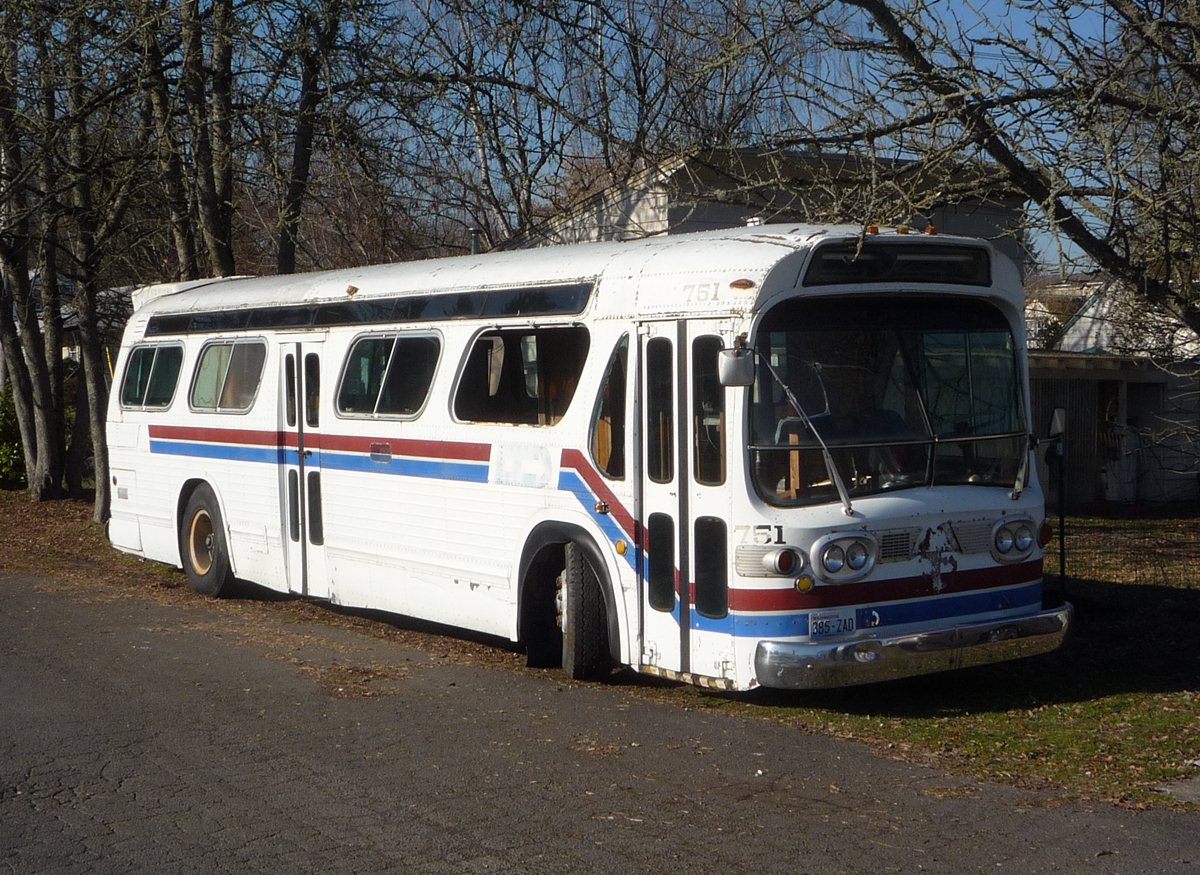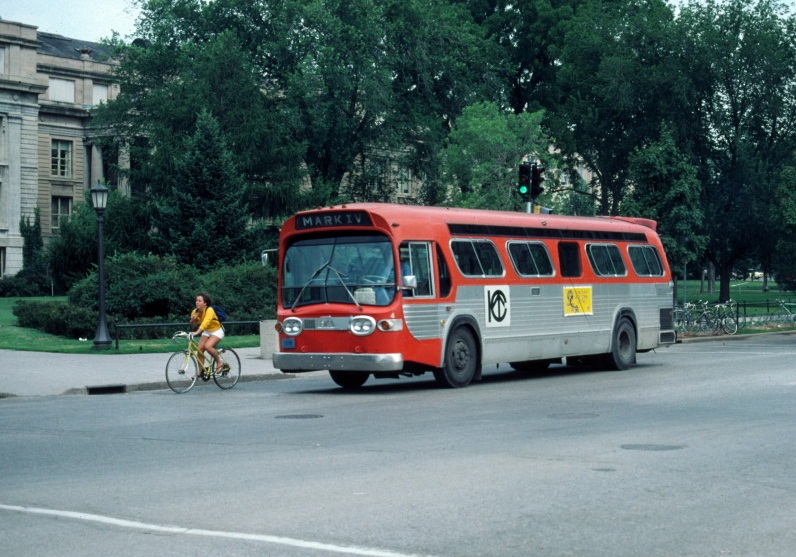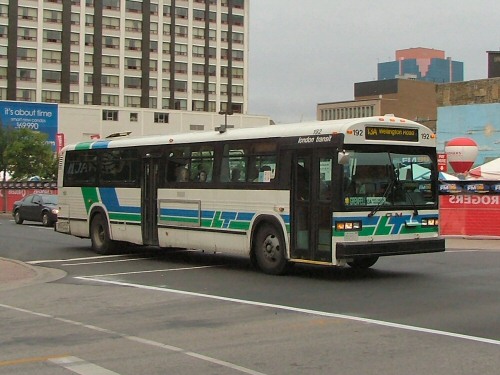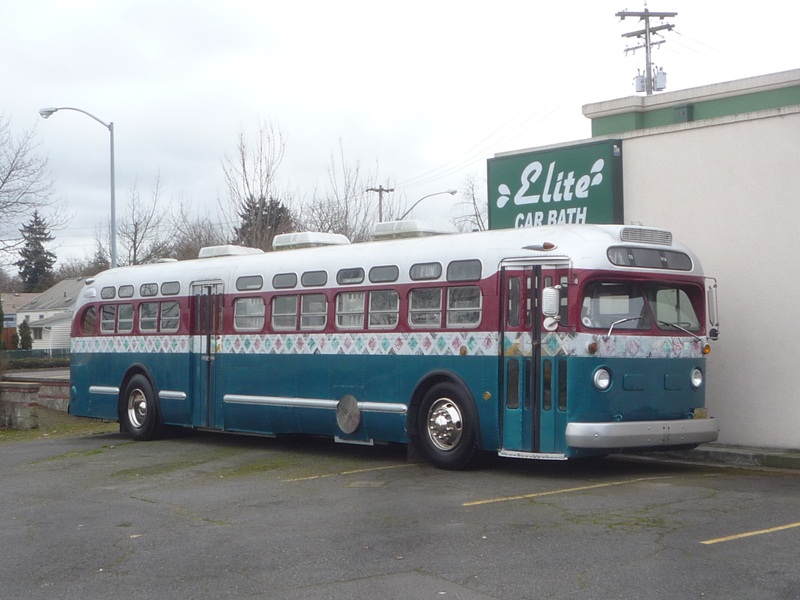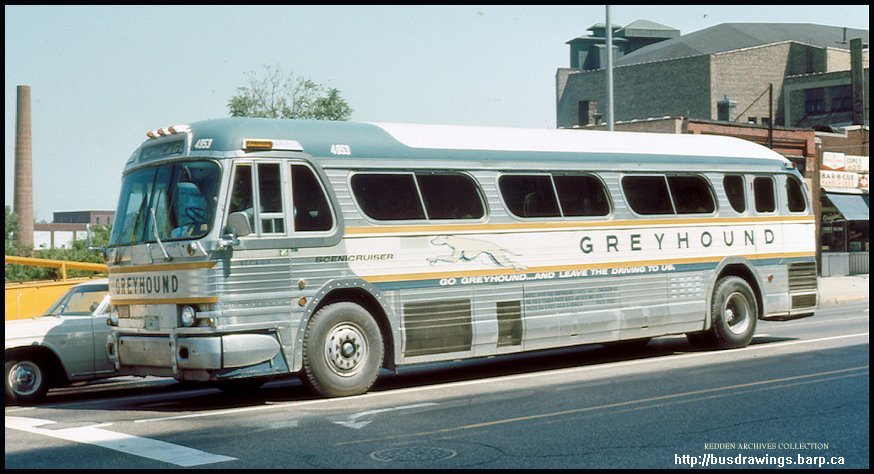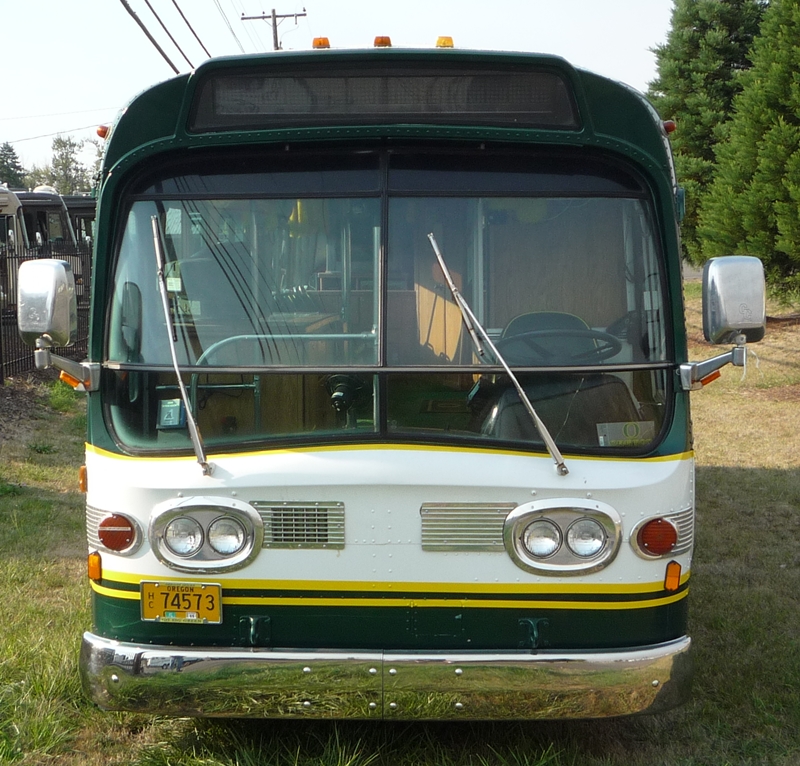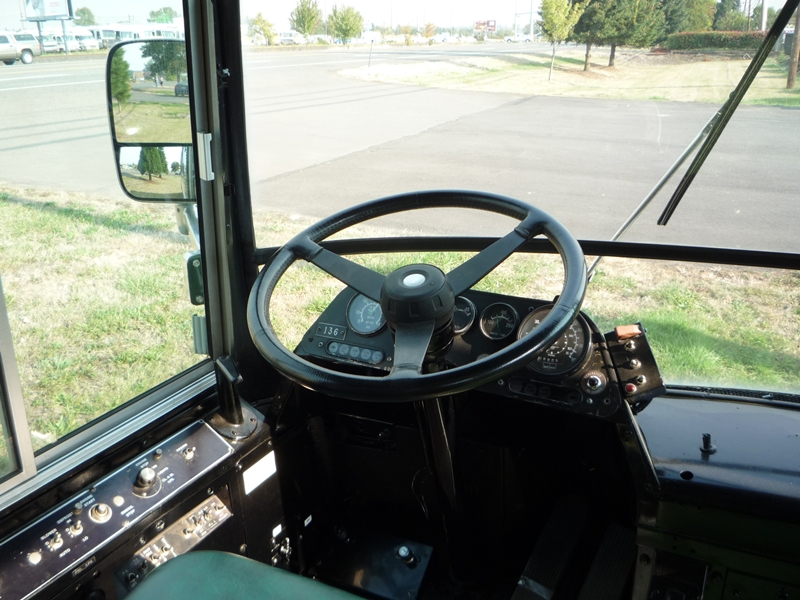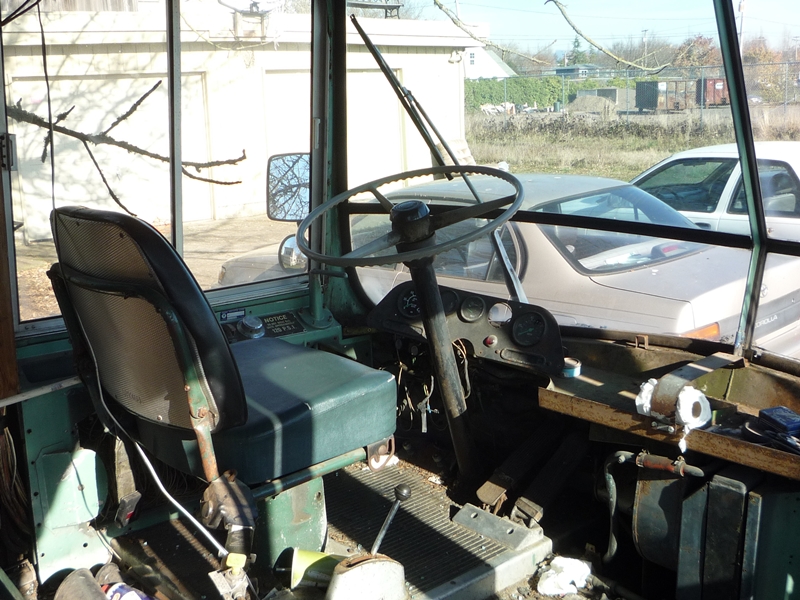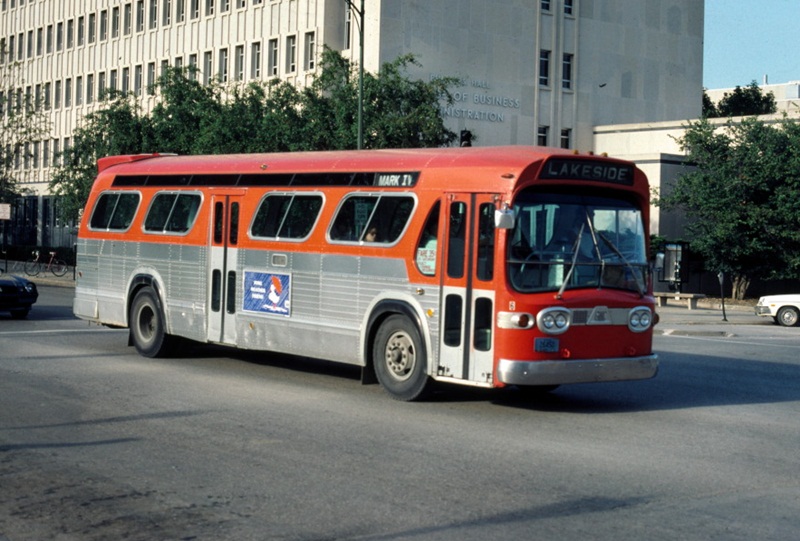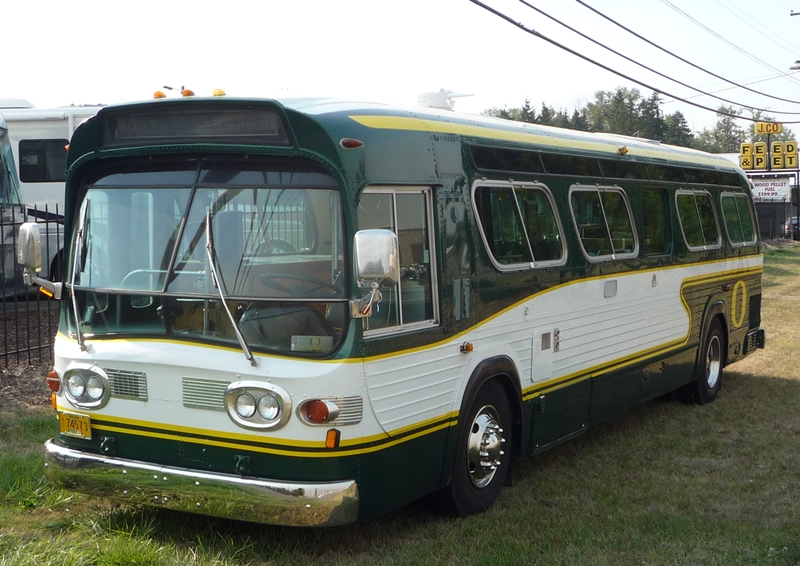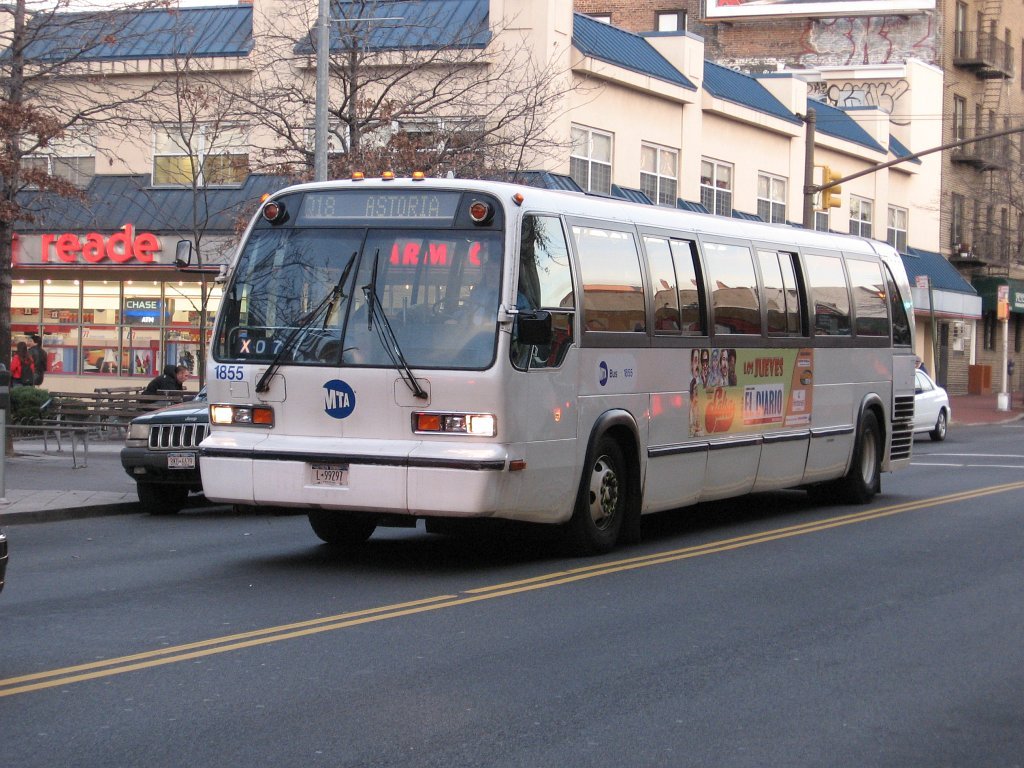(first posted 12/29/2012) GM has built some great vehicles in its day, but nothing can top their buses. They literally owned the bus market from the late thirties through the seventies, having earned that spot with superior technology and quality construction (along with some monopolistic tendencies like buying tram and light rail companies and converting them to buses). One of the most brilliant and enduring examples of that is the “New Look” transit bus that came out in 1959, and revolutionized the field with advanced stress-skin aluminum construction and virtually indestructible build quality.
Some of these buses are still on the road in transit duty decades after they first saw the light of day. I saw one on a passenger run in Ashland, OR just two summers ago, but didn’t have my camera at hand. (This picture is of one of the buses I drove in Iowa City in the early seventies).
A variation of this bus (the GM Classic) was still being produced in Canada by MCI until 1997. Given that our featured bus was built about the same time as many of GM’s Deadly Sins, we have here a study in GM contrasts. Of course, even GM’s bus business eventually ended badly in its inimitable way.
We’ve covered the two key chapters of GM bus history leading up to the “New Look” buses. The first covers GM’s development of the first modern diesel over-the road bus. Its technology was soon applied to transit buses; the story of these post-war “Old Look” is here. These post war buses were durable brutes, powered by GM’s legendary Detroit Diesel 6-71 2-stroke diesel engines.
And GM Division Allison’s V-Series automatic was a revolution in itself. Try to imagine shifting a transit bus, double clutching every shift of the four speed un-synchronized transmission with a forty-foot long mechanical linkage. Shifts were extremely slow and arduous. The Allison was the greatest thing that ever happened to transit bus drivers.
The second breakthrough bus was GM’s over-the-road PD 4104 from 1953. It advanced the art of bus-making to a new level, with its advanced aluminum stressed-skin construction. That reduced weight, and made for an extremely rigid and solid monocoque structure. And its second, and perhaps more noticeable breakthrough was air suspension. The increase in riding comfort was dramatic. The PD 4104 set the template for all buses since, and they’re still desirable RV coach conversions.
The 4104 powered by the DD 6-71 and four-speed manual transmission (not so painful for over-the road use) could get up to 12 mpg. And of course, it spawned the legendary 4105Scenicruiser, specifically designed and produced for Greyhound. Unlike most of GM’s other buses, it suffered from some structural problems, and the complicated twin-engine (two 4-71 four cylinders) setup was also problematic, and they were all later rebuilt with a single 8-71V engine. But they were impressive sights in their day, and I remember some memorable trips in them.
GM’s New Look transit buses arrived in 1959, and used the new construction techniques that the 4104 pioneered, as well as the famous “fishbowl” front windshield.
The benefits were manifold, but none more so than for the driver. Visibility was beyond superb; it was like sitting in a green house compared to the “submarine” predecessors. And the steering was substantially lighter because of the lower weight. Note that power steering on these was highly optional; the power came from well developed arm muscles and the leverage of a large wheel and a high (numerical) steering ratio. This example undoubtedly has power steering, given its smaller non-original steering wheel.
Here’s the view of the helm with an original wheel. The shift lever for the Allison VH transmission is clearly visible here; it had only three positions: F N R. The airbrakes did the parking braking. The Allison was a god-send, but a curious affair. It had all of…one speed, technically, but two, in practice. It was really just a torque converter with a massive amount of effective gear range.
On take-off, (full throttle usually) the engine spun up to well into its rev range, and the bus would smoothly lumber away. Depending on vague factors beyond anyone’s apparent knowledge, at some speed between 30 to 35 or so, the torque converter would mechanically lock with a substantial jolt, and now the engine was in direct mechanical drive. With their low (high numerical) rear axle ratio, the transit buses could muster about 50-55 mph or so; the higher-geared Suburban versions could hit maybe 65 on a good day. Keep in mind that the 6-71V made all of 238hp.
My story of driving for Iowa City Transit in 1975-1976 is here. There were 12 of the smaller 35′ long and 96″ wide buses like this one,
and two of the TDH-5304 big boys: 40′ long and 102″ wide, and with the bigger 318hp 8V-71 engine. The 35 footers were nimble compared to the forties, and one could whip them about pretty quickly in some of the older narrower streets of town. But the slightly newer 40 footers had one other nice feature in addition to the bigger engine: the throttle pedal was air actuated, instead of the mechanical linkage of the older buses. Not only did the mechanical linkage engender knee-ache (to go along with the back ache from the mechanical steering), but one jammed up on me one memorable day. E-pedals were still an engineer’s dream.
The bus in this photo has been converted by an enthusiastic Oregon Ducks football fan for game day parties in the parking lot.
That explains the interior remodel: the Ducks party bus.
The other bus I found is an old left-over from Eugene’s fleet of these 4523s, and is the victim of a botched conversion attempt, not an uncommon thing. How compelling it is to buy an a tired old transit bus with millions of miles under its belt to convert to the ultimate get-away vehicle. Some have the resources; others don’t, as these two variations of the theme illustrate graphically.
I’ve been tempted to go down this road myself, especially with a handsome PD 4104 conversion. But it’s probably a good thing I’ve resisted, since I like to take my little Chinook in places a 35′ bus would never get out again. But whenever I see one, it does tug on my heart.
I got distracted on RV conversions, and forgot to talk about how GM’s bus hegemony fell apart. It fell victim to the same factors (and others) that undid its car (and big truck) market share: sinking reliability caused in part due to government influence and a changing marketplace with nimbler new competitors. Since the feds fund the overwhelming share of all transit capital expense (but not operating costs), they started meddling early on with the bus designs themselves. The biggest one was the Transbus project to develop a new generation of buses in the seventies. GM’s proposal for that ill-fated boondoggle evolved into the GM RTS bus (above).
I’m not exactly an expert on the RTS, but it arrived with complications and issues, unlike the New Look buses. The Canadians (wisely) wanted no part in this new generation of buses, and kept the New Look in production for decades. The RTS had a very checkered career, and eventually GM got out of the transit business, selling the RTS design to MCI, which eventually passed it along again. It was an unloved child that ended up in four foster homes before it was finally surpassed by newer and more desirable designs.
GM’s over-the road coach business went on a bit longer, but eventually there were no new products, and it withered away. But GM’s buses from their golden era will undoubtedly be seen on the roads for decades, as RVs and increasingly, as restored classics, or just party buses.
More GMC buses:
GMC TDH-5101 “Old Look” Transit Bus – GM’s Greatest Hit #9 Despite Being The Agent Of A Deadly Sin
1947 GMC PD-3751 “Silversides” Coach – The First Modern Diesel Bus
GMC PD-4501 Greyhound Scenicruiser – Everyone’s Favorite Bus Except For Greyhound And GMC
